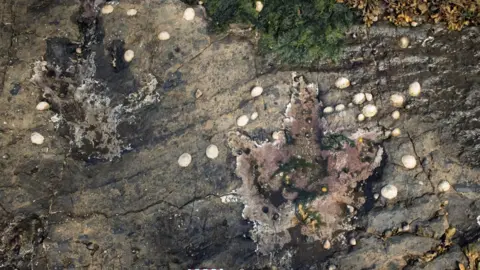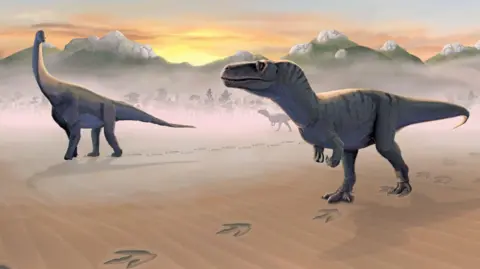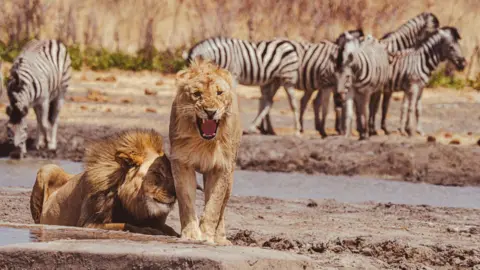Meat-eating dinosaurs shared watering holes with their prey
 Paige E. de Polo
Paige E. de PoloHuge meat-eating dinosaurs and their plant-eating prey shared the same watering holes on Skye 167 million years ago, say scientists.
University of Edinburgh researchers examined dozens of dinosaur footprints at Prince Charles's Point on the island's Trotternish Peninsula.
The dinosaurs included carnivorous megalosaurs - ancestors of Tyrannosaurus rex - and long necked herbivores that were up to three times bigger in size than an elephant.
The scientists analysed the footprints to understand how the animals had moved, and suggested the different dinosaurs had "milled around" shallow freshwater lagoons.
 Tone Blakesley and Scott Reid
Tone Blakesley and Scott ReidThe researchers said the behaviour from the Middle Jurassic was similar to how animals congregated around watering holes today.
More than 130 footprints have been found so far at Prince Charles's Point, on Skye's north coast.
The area is named after Bonnie Prince Charlie who had sought shelter on the peninsula while fleeing British government troops after the Battle of Culloden in 1746.
The scientists said the footprints suggested meat-eating theropods and plant-eating sauropods habitually spent time in lagoons.
They said subsequent discoveries had made the area one of the most extensive dinosaur track sites in Scotland.
 Getty Images
Getty ImagesThe Edinburgh research team's Tone Blakesley said the footprints provided a "fascinating insight" into dinosaur behaviour.
Palaeontologist Steve Brusatte added: "Prince Charles's Point is a place where Scottish history and prehistory blend together.
"It's astounding to think that when Bonnie Prince Charlie was running for his life, he might have been sprinting in the footsteps of dinosaurs."
The first three footprints at Prince Charles's Point were discovered five years ago by a University of Edinburgh student and colleagues.
Important fossil discoveries have been made on Skye over the last 40 years.
They include a pony-sized dinosaur that lived 166 million years ago, and adult and juvenile mammals of the shrew-like Krusatodon.
The island also saw the discovery of the largest Jurassic pterosaur fossil, Dearc sgiathanach - a 170-million-year-old winged reptile.
